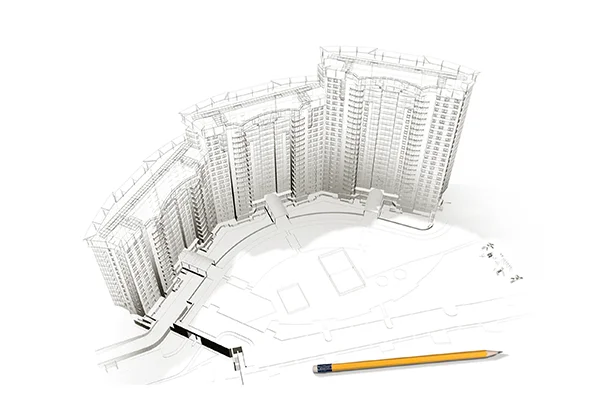
BIM for Structural Engineers – Benefits, Significance, and Work Opportunities
In the realm of structural engineering, Building Information Modeling (BIM) has revolutionized the way professionals approach their work. Gone are the days of relying solely on 2D drawings and manual calculations. BIM has emerged as a transformative technology, offering a plethora of benefits to structural engineers, significantly impacting the industry’s significance, and creating new avenues for work opportunities.
Let’s delve into the world of BIM for structural engineers and explore its top benefits, significance, and the exciting career prospects it presents.
Understanding BIM in Structural Engineering
Building Information Modeling, commonly known as BIM, is a sophisticated process that involves creating and managing digital representations of physical and functional characteristics of structures. Unlike traditional 2D drawings, BIM allows for the creation of 3D models that encompass geometry, spatial relationships, geographic information, and even quantities and properties of building components. This comprehensive digital model serves as a shared knowledge resource for information about a structure, enabling stakeholders to collaborate efficiently throughout the project lifecycle.
Top Benefits of BIM for Structural Engineers
1. Enhanced Visualization and Coordination
BIM’s 3D models offer a tangible representation of the structure, allowing engineers to visualize the project comprehensively. This enhanced visualization aids in identifying clashes and interferences early in the design phase, significantly reducing errors and rework during construction. Structural engineers can also coordinate more effectively with architects, MEP (Mechanical, Electrical, Plumbing) engineers, and other stakeholders, ensuring seamless integration of various building systems.
2. Improved Design Efficiency and Accuracy
With BIM, structural engineers can create detailed, precise models that consider various design scenarios and options. The software’s parametric capabilities enable quick adjustments to designs, facilitating iterative improvements. Additionally, BIM incorporates data-driven analysis, such as structural simulations and load calculations, leading to optimized designs that meet performance requirements while minimizing material waste.
3. Enhanced Collaboration and Communication

Collaboration lies at the heart of BIM. Structural engineers can work concurrently with other disciplines, sharing real-time updates to the central model. This seamless collaboration fosters better communication among team members, reduces misunderstandings, and promotes a holistic approach to project delivery. Clients and stakeholders benefit from clearer visualizations and improved communication of design intent, leading to higher satisfaction levels.
4. Streamlined Documentation and Lifecycle Management
BIM centralizes project information, serving as a repository for all documentation, specifications, and schedules. This centralized data management streamlines the creation of construction documentation, such as drawings and quantity takeoffs. Furthermore, BIM’s “digital twin” concept extends its utility beyond construction, offering valuable insights for facility management and maintenance throughout the building’s lifecycle.
5. Cost and Time Savings
Implementing BIM can result in significant cost and time savings throughout a project. The ability to detect clashes early reduces costly rework during construction. Additionally, accurate quantity takeoffs and material schedules generated from BIM models aid in cost estimation and procurement. The improved efficiency and reduced errors translate to faster project delivery, saving both time and resources.
Significance of BIM in the Structural Engineering Industry

The adoption of BIM in the structural engineering industry signifies a fundamental shift towards more efficient, sustainable, and collaborative practices. Here are some key points highlighting its significance:
1. Technological Advancement and Innovation
BIM represents a leap in technological advancement for the structural engineering sector. It aligns with the industry’s move towards digitization and automation, enabling engineers to leverage powerful tools for design, analysis, and project management. Embracing BIM reflects a commitment to staying at the forefront of technological innovation.
2. Sustainability and Green Building Practices
As the world emphasizes sustainable construction practices, BIM plays a crucial role. Engineers can use BIM to optimize building designs for energy efficiency, material usage, and environmental impact. By simulating various scenarios, BIM helps in creating greener, more sustainable structures that align with modern environmental standards.
3. Industry Standards and Regulations
Many jurisdictions and governing bodies are recognizing the benefits of BIM and incorporating it into building regulations and standards. Structural engineers who are proficient in BIM are better positioned to meet these requirements, ensuring compliance and smoother approval processes for projects.
4. Competitive Advantage and Market Demand
For structural engineering firms, proficiency in BIM is a competitive advantage. Clients increasingly expect BIM capabilities due to its proven benefits in project delivery. Firms that embrace BIM can attract more clients, win bids, and differentiate themselves in a crowded marketplace.
Work Opportunities in BIM for Structural Engineers

The widespread adoption of BIM has opened up exciting career prospects for structural engineers. Here are some of the roles and opportunities within the BIM landscape:
1. BIM Coordinator/Manager
These professionals oversee the implementation of BIM on projects, ensuring that teams adhere to BIM standards and best practices. They manage BIM workflows, resolve technical issues, and facilitate collaboration among stakeholders.
2. BIM Modeler
BIM modelers are responsible for creating the 3D models that form the basis of the BIM process. They translate design concepts into detailed digital representations, incorporating data and information from various disciplines.
3. BIM Analyst
BIM analysts focus on data analysis within BIM models. They perform simulations, conduct clash detection, and optimize designs based on performance criteria. Their insights drive informed decision-making throughout the project lifecycle.
4. BIM Educator/Trainer
With the increasing demand for BIM expertise, there is a need for professionals who can train others in BIM software and methodologies. BIM educators play a crucial role in upskilling engineers and preparing the next generation for BIM-enabled practices.
5. BIM Consultant
BIM consultants offer their expertise to firms looking to implement BIM or improve their existing processes. They provide guidance on software selection, workflow optimization, and BIM implementation strategies.
Building Information Modeling has become an indispensable tool for structural engineers, offering a myriad of benefits that enhance efficiency, collaboration, and project outcomes. Its significance in the industry underscores a shift towards innovation, sustainability, and compliance with modern standards. Moreover, BIM has created a range of work opportunities, from BIM coordinators to educators, presenting exciting career paths for structural engineers looking to thrive in a digitally-driven world. As the industry continues to evolve, proficiency in BIM will remain a valuable asset, shaping the future of structural engineering.
This article has provided an overview of the top benefits of BIM for structural engineers, its significance in the industry, and the diverse work opportunities it presents. By embracing BIM, structural engineers can navigate the complexities of modern construction projects with greater efficiency, accuracy, and innovation.
